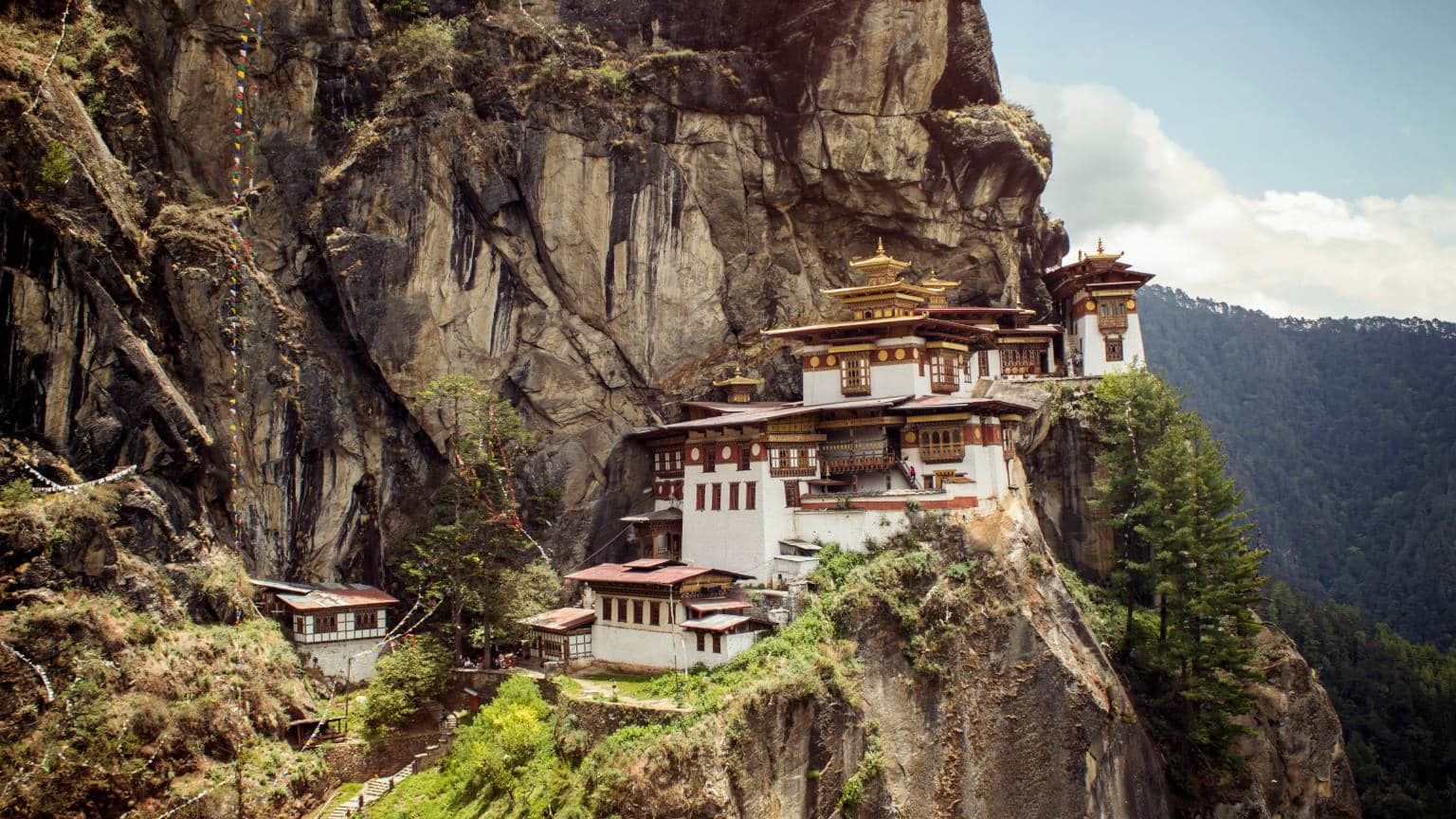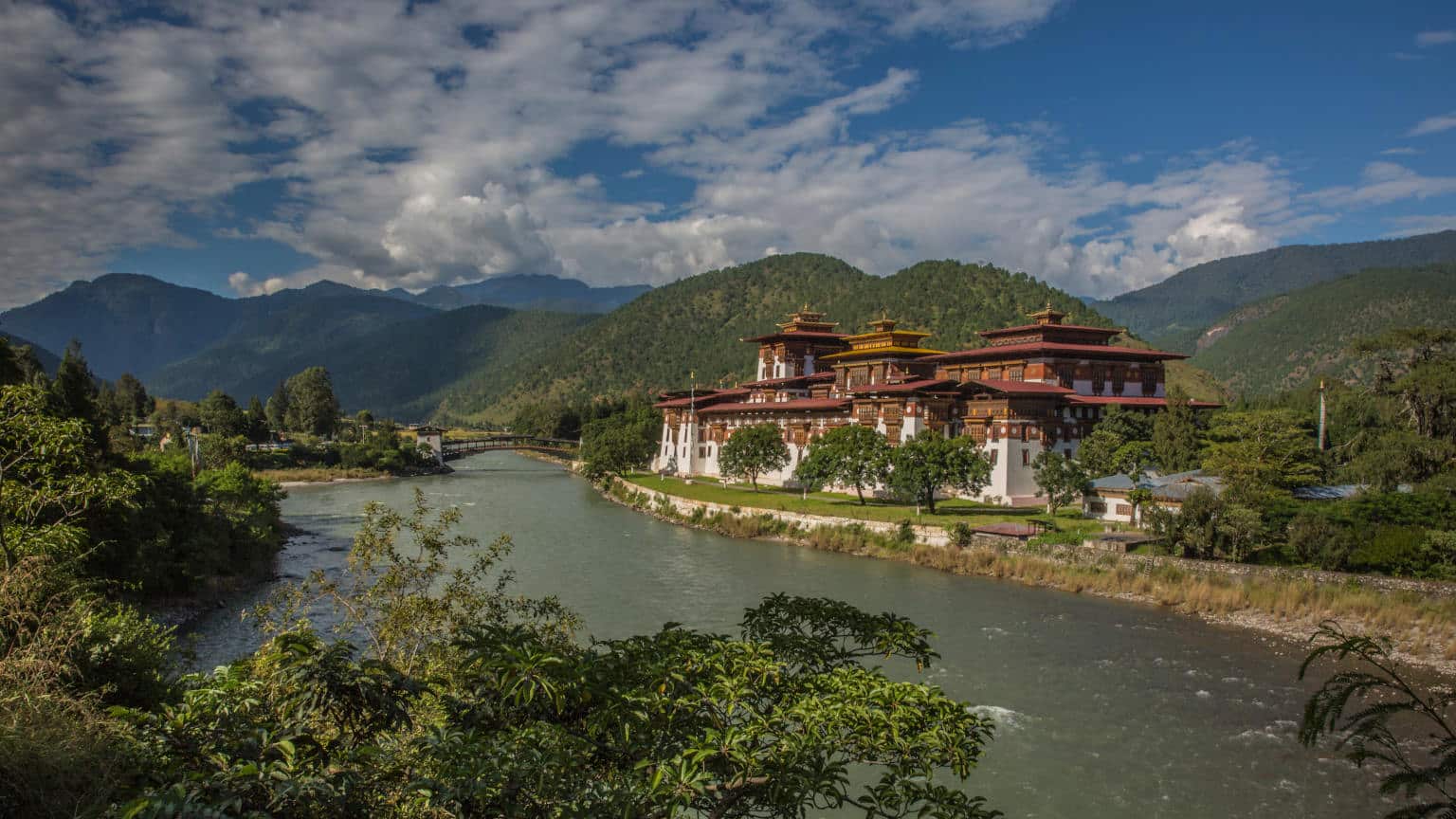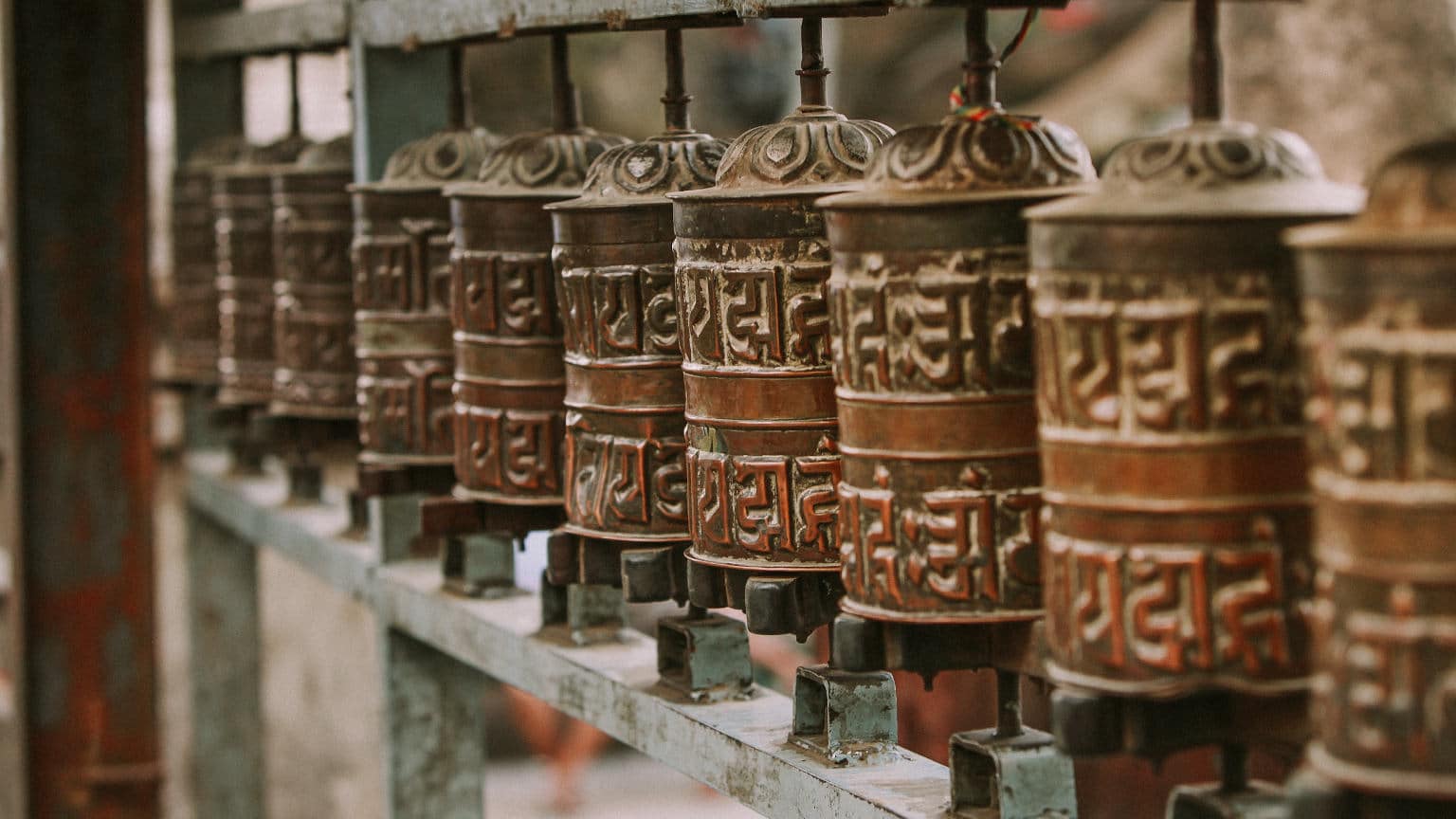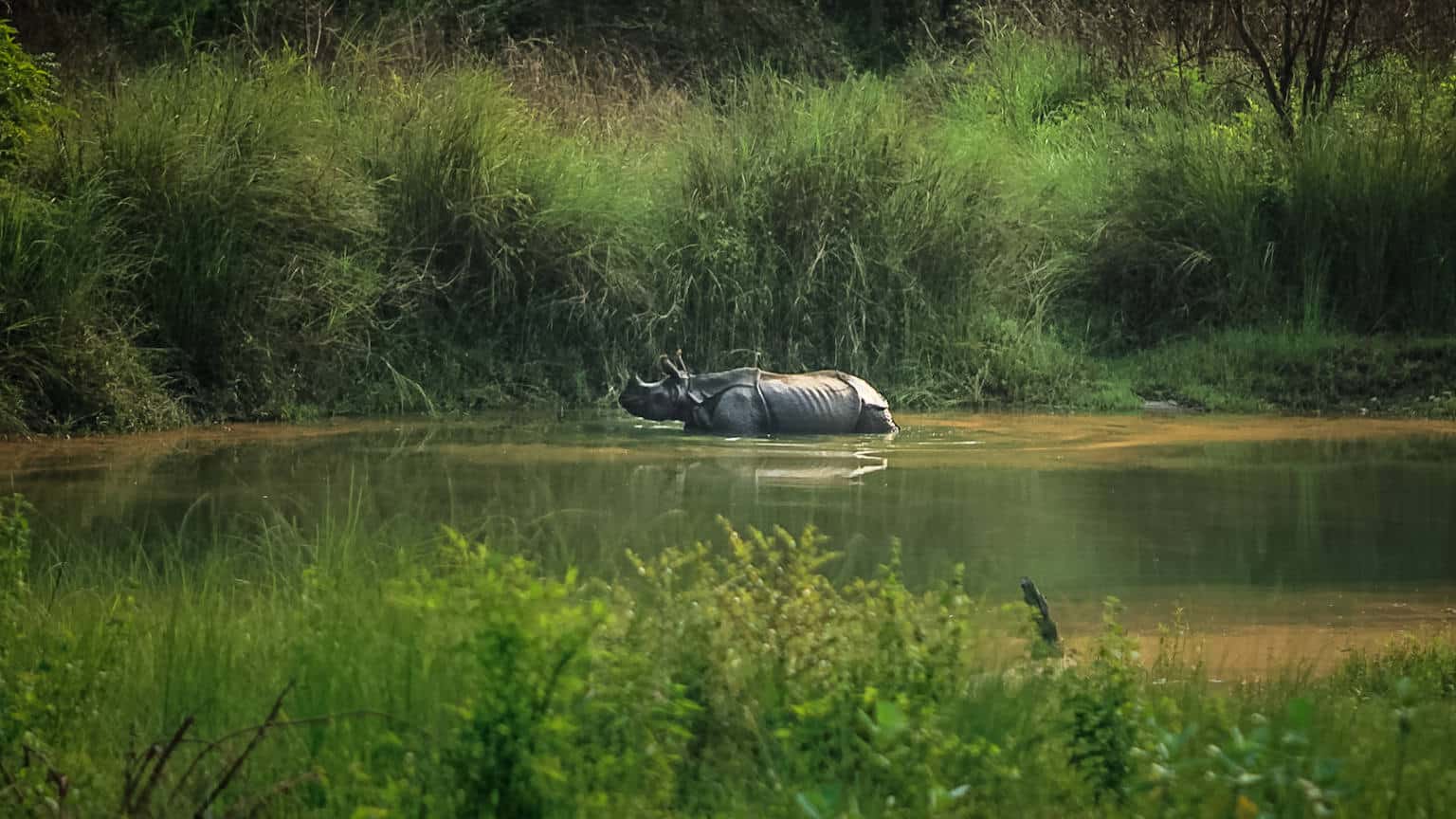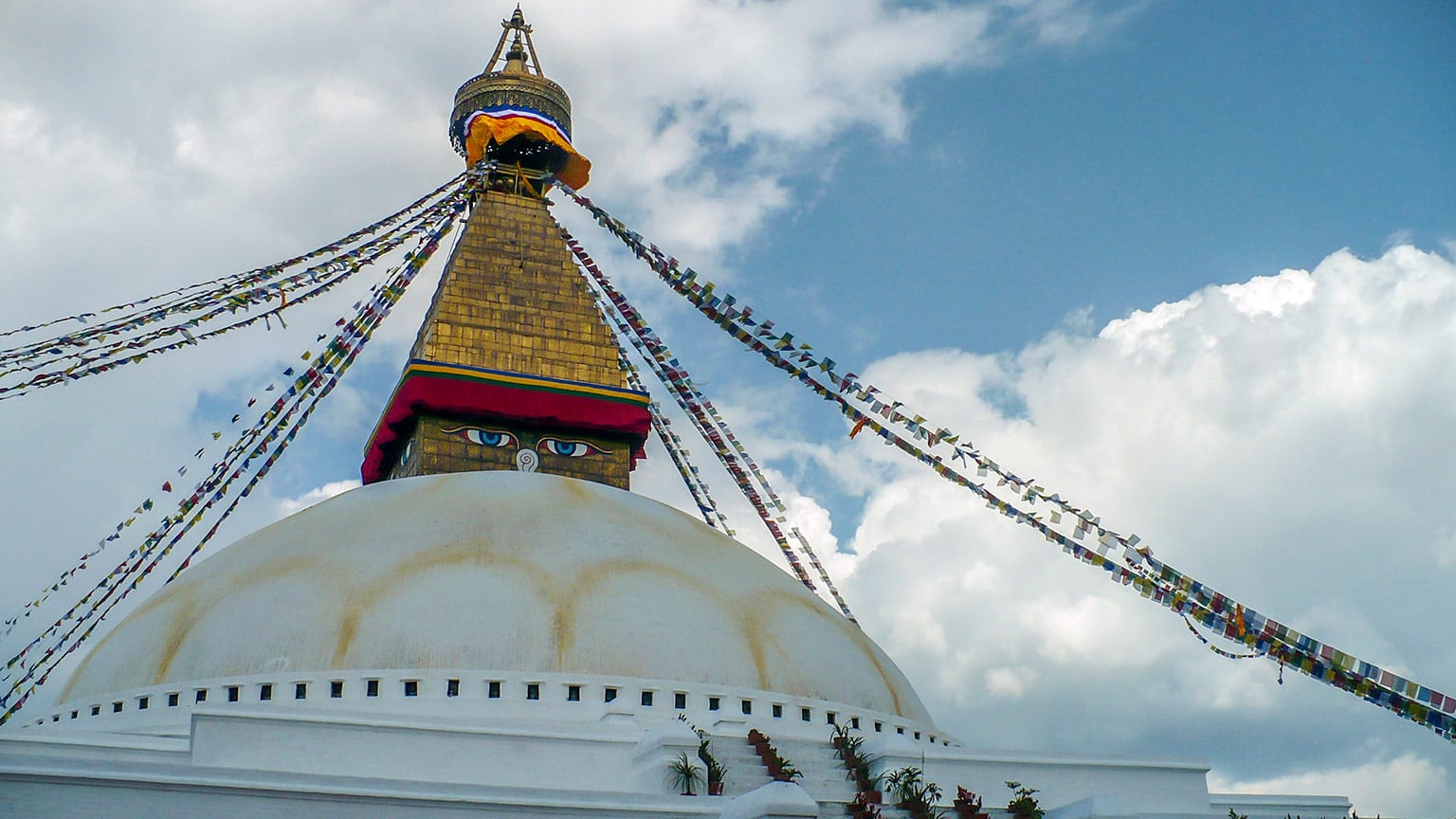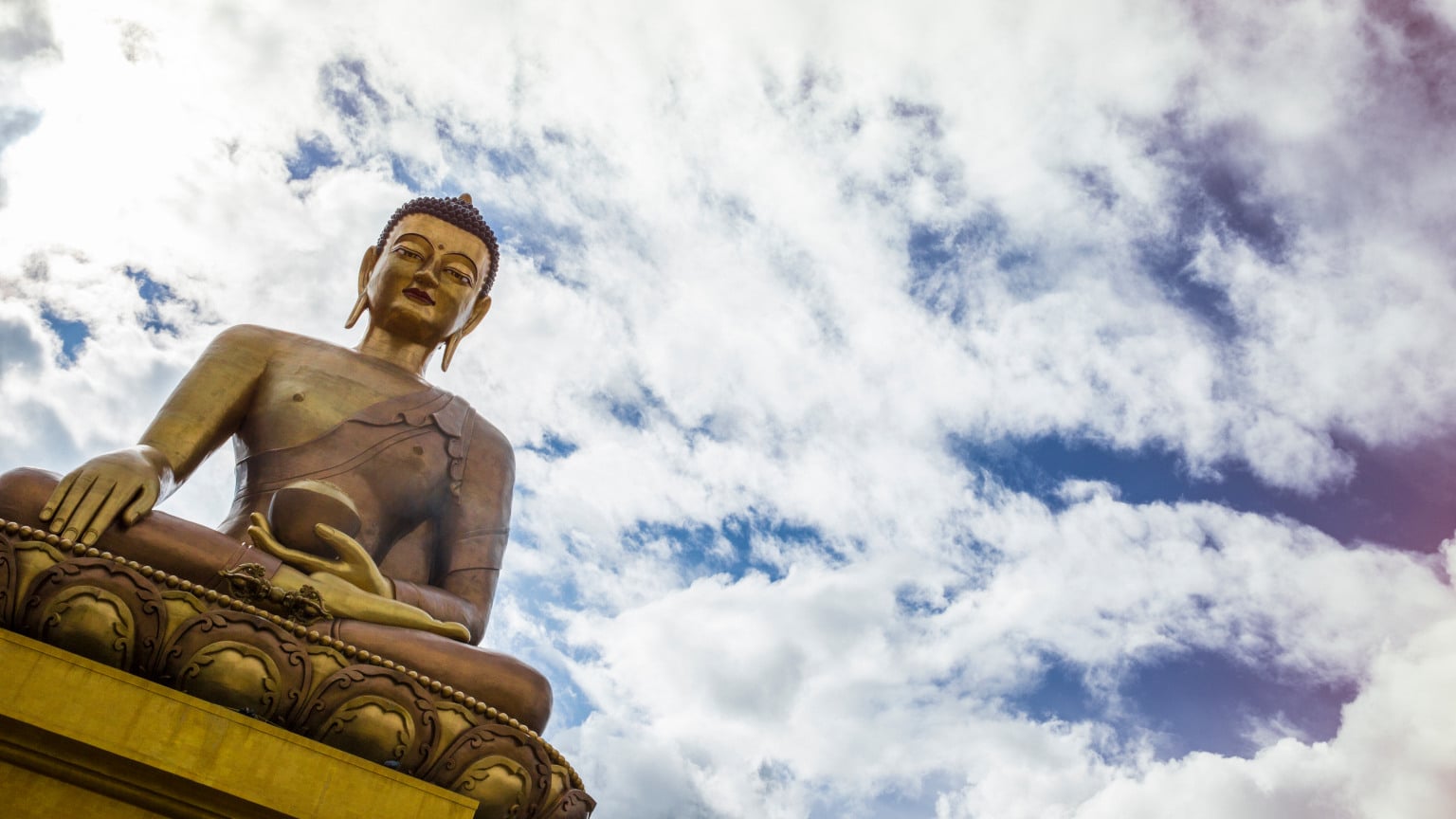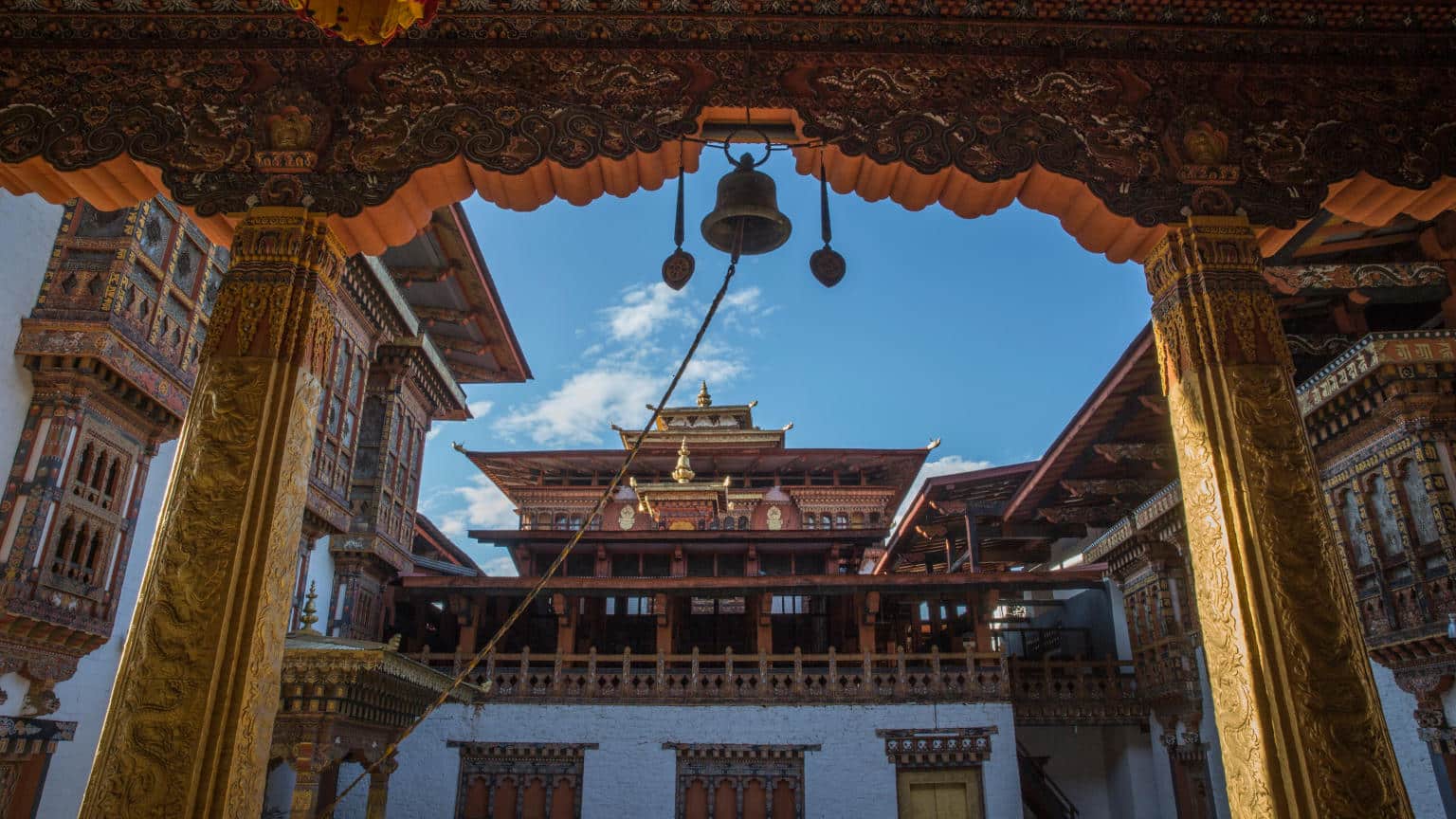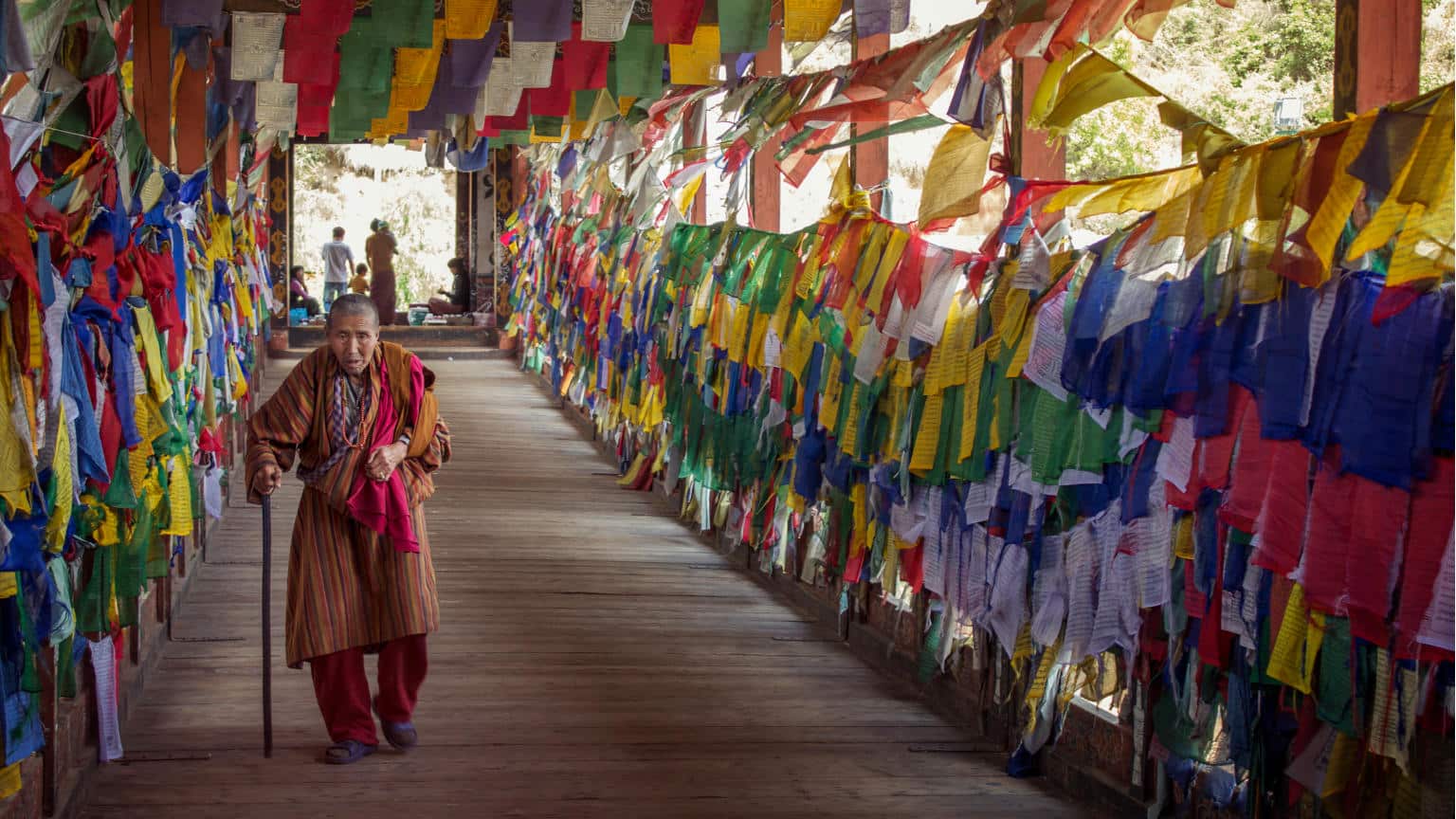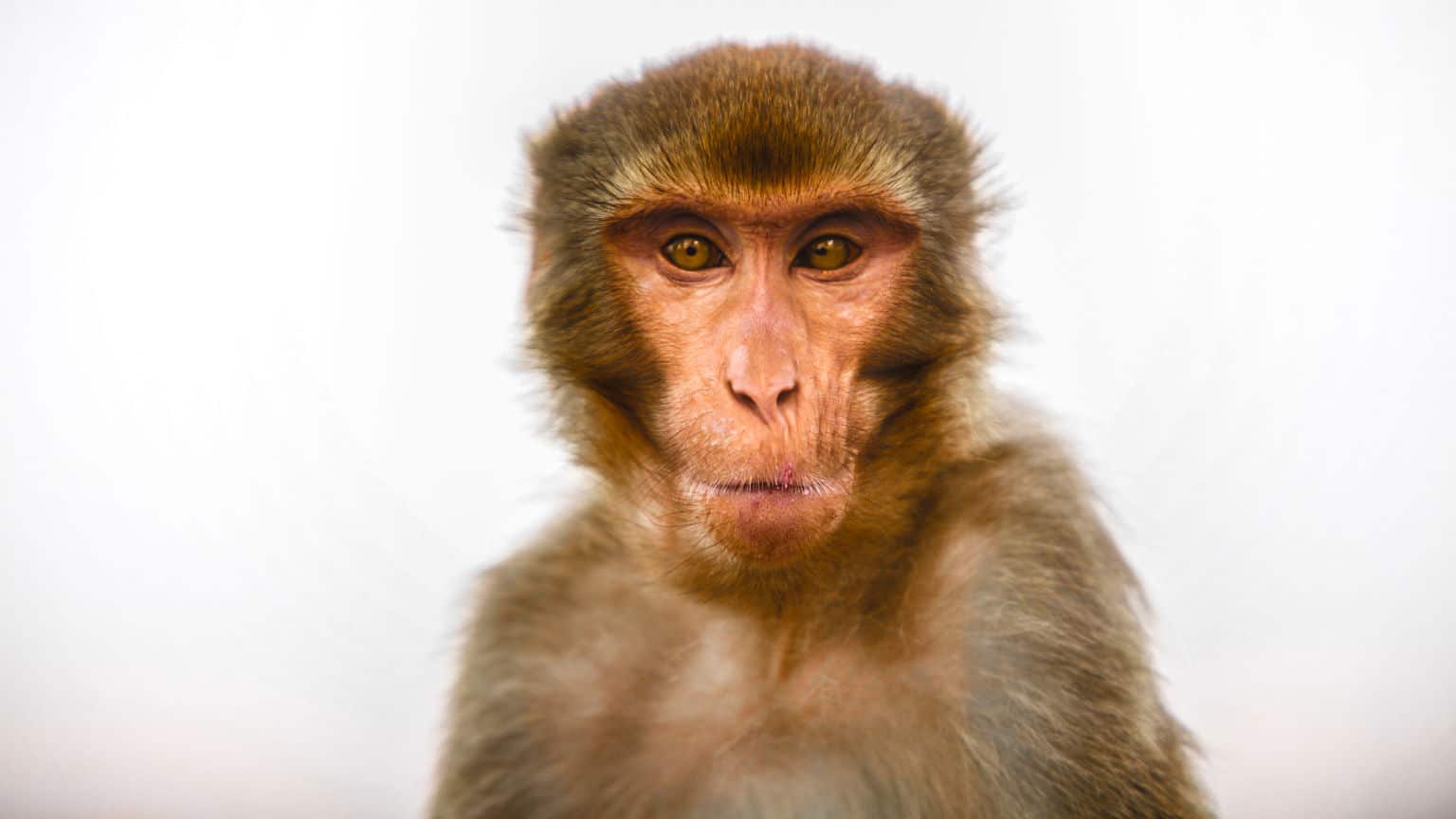Price
 $3609
$3609
Please note that Bhutan flights do not show up in most travel search engines (like Google Flights). Instead, you can search for flights on the Drukair and Bhutan Airlines websites. If you would like assistance searching for flights, please feel free to contact us.
Overview
Explore the Himalayas in two amazing countries, Nepal and Bhutan. You’ll take part in the traditions of small Nepalese communities, experience the wildlife and rich biodiversity of Chitwan National Park, and feel Bhutan’s spiritual nature in storied Buddhist temples. This adventure might be big, but the journey won’t ever feel rushed, meaning you’ll have plenty of time to meet local people and embrace their way of life—all while earning professional development credit with other educators.
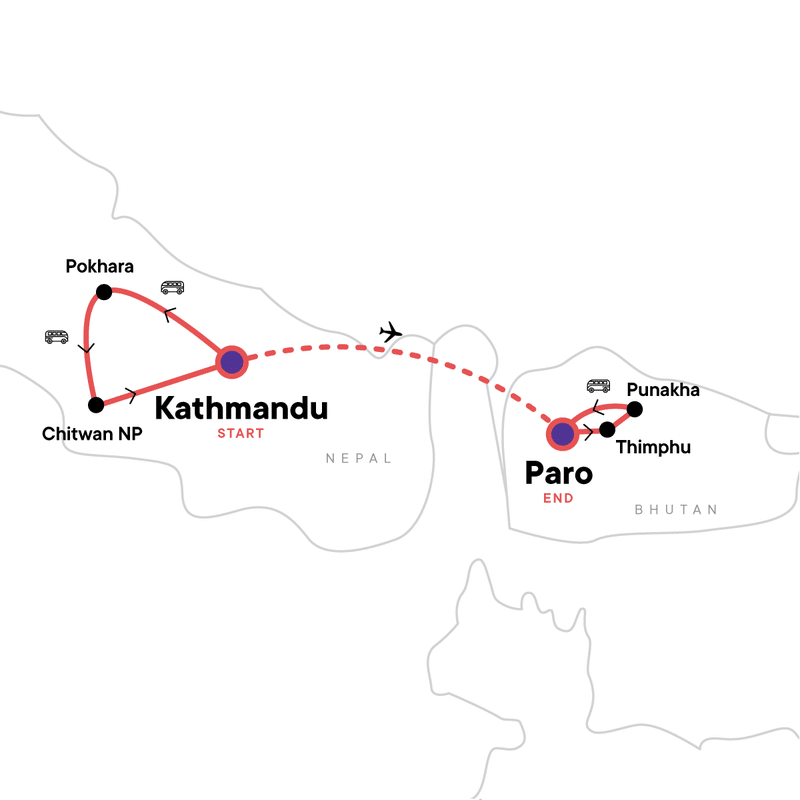
GEEO will be partnering with the South Asia Institute at the University of Texas. They will help lead a pre-trip orientation meeting. They also hope to send a representative of UT Austin to provide guidance to teachers during the trip.
What's Included:
- Walk in Patan Durbar Square
- Sustainable Development Fees
- Guided tour of Bhaktapur City
- Nepalese Dumplings Cooking Demonstration
- Boudhnath Stupa visit
- Enjoy a welcome by the Chitwan Community Homestay and a traditional meal
- Chitwan National Park 4x4 safari
- Cycling through villages in Chitwan
- Memorial Chorten & Motithang Takin Preserve visit
- Tashichho Dzong visit
- Chimi Lakhang Hike
- Explore Paro Dzong and Archery grounds
- Hike to Taktsang Monastery Tiger's Nest
- Departure transfer to Paro airport
- Bhutan visa support
- Internal flight from Nepal to Bhutan
- G Adventures Tour leader throughout, local guides
- 5 breakfasts, 5 lunches, 6 dinners – allow $240-$315 USD for meals not included
- Hotels (10 nts), guesthouse/cottage (2 nts)
- All transport between destinations and to/from included activities by private van, 4x4, riverboat, plane
What's Not Included:
- International air travel
- Incidentals
- Travel health and cancellation insurance
- Applicable visas
- Tips or gratuities
- Airport taxes
- Beverages
- Meals not mentioned in itinerary
- Optional tours and admissions
- Arrival airport transfer
Itinerary Download PDF
Arrive in Kathmandu at any time. Due to the potential for flight delays or cancellations, we recommend that you plan to arrive in South Asia at least a day in advance. This will also give you time to adjust to the time difference and overcome any jetlag. We can book extra hotel nights for you in Kathmandu before the trip. We also recommend booking an arrival airport transfer through us ahead of time—or paying for a transfer inside the airport—rather than trying to catch a taxi outside the airport. Please note that check-in at the hotel is usually around 2:00-3:00 p.m. There are no planned activities until an intro meeting around 6:00 or 7:00 p.m., usually in the hotel lobby. Check for a sign or ask at the reception desk about the exact time and location of the group meeting. Please make every effort to arrive in time for this meeting. If you are delayed and will arrive late, please inform us. Your tour leader will then leave you a message at the front desk informing you of where and when to meet up tomorrow. After the meeting, you might choose to get dinner at a nearby restaurant with your traveling companions and your tour leader to further get to know one another. After the orientation meeting, enjoy a self-guided tour of the spectacular Pata Durbar Square, built primarily in the 16th and 17th centuries. Located in the square are the Royal Palace and many temples built in the traditional Newari pagoda style. You will also visit the Golden Temple and Patan Museum. South of the square lies the Kumari Chowk, home to Nepal's living goddess, the Kumari, a prepubescent girl chosen as the incarnation of the Hindu goddess Talejn. The Kumari lives a cloistered life, rarely leaving the confines of the chowk. When she does, it is for important religious festivals, but her feet are not allowed to touch the ground. Once the Kumari reaches puberty, another 3-5-year-old girl will take her place. If she is receiving visitors, we may be able to stop by for a blessing.
Kathmandu, Patan, and Bhaktapur constitute the valley’s three medieval Newari cities. Today, our group will go on a guided tour of Bhaktapur. Bhaktapur is the best preserved of the three cities, with incredibly well-preserved ancient architecture, much of which withstood a devastating earthquake in 2015. The ancient town, known as the City of Devotees, was founded in the 12th century and became renowned for its culture, festivals, and multitude of Hindu temples. Explore Bhaktapur's markets, tea stalls, wood-carved temples, and vibrant squares, including Durbar Square. You can pick up clay pots and other souvenirs in the colorful open markets and taste homemade yogurt, known as khopa dhau, which Bhaktapur is famous for. We will also visit the Bodhnath Stupa, one of the largest Buddhist stupas in the world. Built in the 5th century, this UNESCO World Heritage site still attracts many pilgrims, particularly Tibetan Buddhists and local Nepalis. Take in the peaceful atmosphere and observe Buddhist monks in prayer in the monasteries surrounding the stupa. Afterward, enjoy a cooking demonstration at a local establishment and learn how to make momos (traditional dumplings). Afterward, taste the delicious dishes made with an included Nepali lunch. The evening is free to do as you please. Approximate travel time: 1 hr by private vehicle
Drive across the mountains to beautiful Pokhara. Immerse yourself in the views of the spectacular Annapurna Range. The drive is long, and the road is curvy and can be rough. You also have the option to upgrade to a flight from Kathmandu to Pokhara for $133. Upon arrival in Pokhara, breathe in the fresh air and take in the views of the Himalayas and Phewa Lake while getting your bearings around this scenic city with an orientation walk. Approximate travel time: 8-9 hrs by private vehicle
Spend the day as you please, indulging in a variety of optional activities in Pokhara. Find a cute cafe to sip some tea in or maybe go for a short hike in the Annapurna ranges. You could also walk up to Sarangkot for incredible views or spend time boating in Phewa Lake and walk through the gardens.
Leave Pokhara behind and transfer by private vehicle to Chitwan. Enjoy the hospitality of the Tharu, an indigenous community from the Teral belt of Nepal who live in eco-friendly homes. Experience their unique culture through dances, songs, and a delicious traditional meal. Stay on the property in private guesthouses that resemble the traditional village architecture of the local Tharu people. Enjoy modern conveniences like running water, comfortable beds, and mosquito nets. The 14 cottages are each named after the local woman that manages the property. There are also tended gardens and small patches of farmland in the village compound with animals tethered inside the pastures. Any meals will be eaten in the communal dining hall, and the local women will serve you food entirely sourced from the surrounding land and community. Approximate travel time: 4-5 hrs by private vehicle
Today we explore the UNESCO World Heritage-listed Royal Chitwan National Park in a 4x4 jeep safari. Keep your eyes peeled for the many animals that live there, including birds, monkeys, crocodiles, and rhinos. If you're lucky, you might get to see an elusive tiger. You will also have some free time in the park. Known as the Terai Tarai ("moist land"), the landscape you travel through today is a belt of marshy grassland, savannah, and forests at the base of the Himalayas. The Terai-Duar region is home to the endangered Indian rhinoceros, as well as elephants, Bengal tigers, bears, leopards, and other wild animals. The Royal Chitwan National Park and Royal Bardia National Park preserve significant sections of habitat for these animals, making them home to some of the greatest concentrations of rhinoceros and tigers left in South Asia. Later, explore the village and its surroundings with a guided bike ride. Enjoy the sunset on the banks of the Narayani River over a cup of tea.
We will return to Kathmandu and where you will be able to enjoy a free afternoon to continue exploring or shopping. We recommend visiting the burning ghats at Pashupatinath and Swayambhunath, also known as the Monkey Temple. Approximate travel time: 6 hrs by private vehicle
Fly from Nepal to Bhutan today for the start of the next leg of your adventure. Your Nepalese tour leader will drop you off at the airport in Kathmandu, and you will be picked up by your Bhutanese tour leader in Paro. You will be transferred from the Paro airport to Thimphu where you will have a group dinner. Thimphu is the capital of the Himalayan kingdom of Bhutan. It is also Bhutan's largest city and displays loads of traditional Bhutanese art, architecture, and culture. It's a modern city with a unique character. You'll see the old and the new blend together here as you walk the streets lined with restaurants and cafes that sit alongside old fortresses and monasteries. Did you know that Thimphu is the only capital city in the world without any traffic lights? Get to know the area on an orientation experience by visiting sites like the textile museum and old clock tower. In Bhutan, all meals are included in the trip's price, including tonight's dinner. Approximate travel time: 1 hr by plane, 1.5 hrs by private vehicle
Start the day off with a visit to the National Memorial Chorten. The chorten is one of the most prominent religious structures in Thimphu, and for local Bhutanese, it is a popular part of their daily prayers. Watch locals walk around the Chorten, spinning the prayer wheels and meditating in this lovely and peaceful spot. We will then travel to "Buddha Point," home to Thimphu’s most recognized landmark, the Buddha Dordenma. Guarding the entry to the Thimphu Valley, this 51-meter (167ft) gilded bronze statue is filled with 125,000 miniature statues and sits atop a three-story base housing a chapel and thousands of donated statuettes. The statue was commissioned to mark His Majesty the Fourth King of Bhutan, Jigme Singye Wangchuck’s 60th birthday and was initially made in China before being transported to Thimphu in pieces. Later, visit the Motithang Takin Preserve, which was once a mini zoo. The area was converted into a preserve for Bhutan's national animal, the takin, a cross between a goat and an antelope. In the evening, visit the Tashichho Dzong, a Buddhist monastery and fortress. Its main building is typical of Bhutanese architecture, with whitewashed walls and a golden roof. The original structure was built in 1216 and now houses the civil government.
We depart the Thimpu Valley and drive to Punakha, with a stop at the Dochula Pass. This mountain pass is 10,171 feet above sea level. The wife of the former King of Bhutan has built 108 stupas here in honor of Bhutanese soldiers who were killed in a battle against insurgents from India in 2003. When the weather is clear, the pass offers panoramic views of the Himalayan Mountains. After arriving in Punakha, we will take a short hike to Chime Lhakhang, temple of the “Divine Madman." We'll pass through rice patties, a small neighborhood, and then up steep stairs to get to the temple. Built in 1499, it is mainly visited today by women as it is known as the temple of fertility. The hike there and back will take about a little less than an hour. In the afternoon, we visit Punakha Dzong. The winter seat of the Je Khenpo and the Monk Body, it is located between the rivers of the Mo (female) Chu and Pho (male) Chu. It is the second oldest and second largest dzong (fortress) in Bhutan and one of its most majestic structures, housing many sacred relics. It is also the winter capital of the Je Khenpo (chief abbot). Built by Zhabdrung Ngawang Namgyal in around 1637. Arguably, it is the most beautiful Dzong in the country. The Dzong guards Bhutan’s most treasured relic, the Rangjung Kharsapani, an image of Chenresig kept away from the public in the utse (tower). It has survived Tibetan invasions, numerous fires, floods, and a glacial lake burst. The Dzong served as the capital and seat of the Bhutanese Government until the early 1950s; and the coronation of the His Majesty the First Druk, Gyalpo Ugyen Wangchuck, took place here. Approximate travel time: 3-4 hrs by private vehicle
This morning we will drive to Paro, which lies at the center of a valley full of ancient sites and buildings. The area is covered with terraced paddy fields, quaint farmhouses scattered throughout the valley and green forests overlooking the Paro Chhu River snaking below. Enjoy an orientation walk of this beautiful place and learn about ancient Bhutanese artifacts and artwork. We will visit the Paro Rinpung Dzong (fortress), meaning ‘Fortress on a Heap of Jewels”. The original construction of this dzong is believed to have been completed in 1458 and restored to its present glory by His Majesty the Third of Bhutan, King Jigme Dorji Wangchuck, to mark his royal wedding in 1951. If possible, we will visit a local archery ground to watch locals practice or compete with unbelievable accuracy and precision as they hit distant targets. You'll have free time to visit other sites in Paro like the ruins of the Drukgyel Dzong or Kyichu Lhakhang, one of the two oldest monasteries in Bhutan. Maybe head for a visit to the National Museum of Bhutan. There are statues, paintings, sacred masks, and costumes all located in a seven-story watchtower. Approximate travel time: 3-4 hours by private vehicle
Hike up to the Taktsang monastery (Tiger’s Nest), containing 13 holy relics, it's considered one of the most venerated pilgrimage sites of the Himalayan world. It is also where Guru Padmasambhava is said to have landed on the back of a tigress in the 8th century. Take in the stunning views en route and the incredible vista from this monastery, which clings to the rock towering 2,953m above the valley. The group will hike from 7,875 feet elevation to 10,170 feet at the Taktsang Monastery before returning to 7,875 feet on the same day. The climb should take around 6 hours for a total distance of 7 km. Your tour leader can arrange a horseback ride that will take you roughly halfway to the Taksang Monastery. A handler leads the horse, so is possible for travelers who have little to no experience riding horses. You will have some free time in Paro after you return for last-minute shopping or exploring. We'll also have one last group dinner.
There are no planned activities today, so you may depart Paro at any time. A complimentary airport transfer is included, and your tour will help arrange all exit formalities before you begin your journey home. Your fellow travelers are also likely to be on the same flights, either to Kathmandu or Delhi. If you wish to extend your stay in Paro, consider booking post-tour accommodation with us. Please note that check-out time from the hotel is usually mid-morning, but luggage storage services are available at the reception desk. Want more adventure? Book two or more GEEO programs in the same school year and receive a discount! GEEO will give you 10% off of the lesser value program(s) (up to 3 programs per year). If you would like to extend your time abroad but don't see another GEEO program that interests you, let us know. We can work with you to find a trip from our tour operator’s much larger catalog. Their tours are open to the general public and not designed specifically for educators, but we can still offer you and your travel companions a discounted educator price on any additional tours that you book.
Details
Frequently Asked Questions
Please read our general FAQs, where you can find essential information that applies to all of our programs.Resources to Learn & Teach about Bhutan & Nepal
Visit our recommended reading page to see the list of books GEEO recommends reading before your program (this is not required reading). We also have lesson plans and Pinterest boards that may be useful for you as you learn about your destination and prepare to bring lessons back to your classroom.Terms and Conditions
It is very important for you to visit our Terms and Conditions page before signing up for this program.GEEO Program Confirmation Process
We require a minimum of 6 participants for most GEEO programs. We officially confirm that a program will run once at least 8 people have signed up, which provides a margin for individual cancellations. Nearly all GEEO programs ultimately meet this enrollment quota, and in the rare event that a program does not meet the minimum requirement and GEEO cancels the program, we will work with you to find a suitable alternative or provide a refund of your deposit if you prefer. We encourage you to sign up for any program that interests you, and we will notify the entire group once 6 people are booked and again once 8 people are booked. We always emphasize the importance of exercising caution when making non-refundable travel arrangements, especially given the unpredictable nature of travel. For example, we typically recommend booking flights with flexible change/cancellation policies.Cancellation policy
All cancellations must be submitted to GEEO in written form by emailing your request for cancellation to travel@geeo.org. If you do not receive a confirmation that we have received your written cancellation request, please call us at 1-877-600-0105. Verbal cancellation requests will not be honored.- If you cancel 60 days or more prior to departure, all your program fee payments will be refunded besides your $350 deposit which is kept on file for future use
- If you cancel between 30 and 59 days prior to departure, you will receive a 50% refund and your deposit is kept on file for future use
- If you cancel within 30 days of departure, you will receive no refund, but your deposit is kept on file for future use
Trip Notes
- DRONES: Please note that drones and the flying of drones are prohibited in Nepal and Bhutan. If you violate these regulations, the police may take you into custody.
- TOURISM RULES: Bhutan has unique tourism rules as they seek to limit the impact of travelers on their country. The Bhutan portion of this trip pretty much includes all of the costs in the price.
- MEALS: Most meals in Bhutan are included in the cost of the trip – some are in the accommodation where it is the best quality/availability option. Most meals are served buffet-style with a selection of traditional Bhutanese food, some western-style (often pasta), as well as some Chinese. Fresh local vegetables are in abundance, and while Bhutan is mostly vegetarian, there usually is one meat dish available (on some occasions, there can be shortages, as all meat is imported from India).
- CAMERA RULES: Please note there may be times during your visit to Bhutan when the use of video and/or still cameras may be inappropriate. You cannot take pictures or videos inside temples. Local people may consider that filming is too intrusive, and in these circumstances, we will request that you do not film. At all times, be aware and sensitive to the impact of photography, and seek permission before taking photographs of people and respect their wishes if they refuse.
- DOGS: There are barking of dogs at night, which can be annoying. It’s advisable to bring earplugs.
- CLOTHES: Bhutan is very conservative and you should dress accordingly. As a general guideline, shoulders and legs should be covered at all times. The wearing of shorts is not allowed (except while hiking), as it will restrict your entry into buildings of a religious nature and family homes. A water and windproof jacket is useful and a hat and sunscreen essential. Due to the altitude, it can be cold in the mountains even in the summer.
- ARRIVAL/DEPARTURE FLIGHTS: Your flights out of Paro, Bhutan, must be booked by you online directly through either of the two airlines that fly out of Paro. See further below for more info.
- KATHMANDU-POKHARA FLIGHT: The drive from Kathmandu to Pokhara is long, and the road is curvy and can be rough. If you prefer a smoother journey and want to avoid the bus ride, you can upgrade to a flight from Kathmandu to Pokhara for $133. This flight will need to be arranged in advance.
- EXTRA NIGHTS: If you are planning to extend your stay in Bhutan, post-tour accommodation MUST be booked through GEEO in order for us to issue a valid visa for the duration of your stay. These extra nights will include a guide and meals in addition to the accommodation.
Group Leader Description
All GEEO/G Adventures group trips are accompanied by one of G Adventure’s group leaders, which they refer to as Chief Experience Officers (CEOs). The aim of the group leader is to take the hassle out of your travels and to help you have the best trip possible. They will provide information on the places you are traveling through, offer suggestions for things to do and see, recommend great local eating venues, and introduce you to our local friends. Our itineraries often have plenty of free time to explore on your own. While not being guides in the traditional sense, you can expect them to have a broad general knowledge of the countries visited on the trip, including historical, cultural, religious, and social aspects. We also use local guides where we think more specific knowledge will add to the enjoyment of the places we are visiting – we think it’s the best of both worlds. You will have different tour leaders in Nepal and Bhutan. The Nepalese guide will help get you into the airport in Kathmandu, and the Bhutanese tour leader will pick you up as soon as you exit the airport in Paro.Fitness Level
Trip includes some high-altitude hikes or more strenuous activities, but it is accessible to most healthy travelers.Single Travelers
Half of GEEO’s participants travel by themselves, so please don’t worry if you do not have a travel companion for your trip. Our program fee is for one traveler in double-occupancy accommodation, and GEEO can find you a roommate of the same gender if you do not have a travel companion. Most of our programs have a “My Own Room” option, also known as a “Single Supplement,” which is an extra fee that you can pay to have a room to yourself. You will only incur an additional charge if you specifically request a single room. To see the price for the “My Own Room” option, please find your program on our extra services page. If you want to room alone, please email travel@geeo.org to request a single room.Joining Instructions
Day 1 is an arrival day, and no activities have been planned. Upon arrival to the city on Day 1, or earlier if you have booked pre-accommodation with us, please make your way to the joining hotel. Please note: Check-in time will be in the afternoon. Once you arrive at the hotel, look for a note at reception from your tour leader. This note will give the details of your Welcome Meeting on Day 1, usually between 6:00 p.m. and 7:00 p.m., during which you will get a chance to meet your tour leader and other travelers, as well as learn more about how the tour will run. If you don’t see a note, please ask reception for details. If you miss the Welcome Meeting, your tour leader will leave a note at reception for you with any information you may need and with instructions for the next morning. When arriving at Tribhuvan International Airport in Kathmandu, you will notice from the sky how small the city is—the distance from the downtown area to the airport is only 7 km, and the only way to get there is by taxi. You can arrange a prepaid taxi with the Airport Queue Taxi Service Management Committee from a counter in the airport near the baggage hall. The cost is around 700-800 NPR. Please be aware that you may be approached by people offering to help you with your luggage; if you accept, they will ask for money once you reach your taxi.Emergency Contacts
Should you need to contact G Adventures during a situation of dire need, it is best to first call their local G Adventures office. If for any reason you do not receive an immediate answer, please leave a detailed message and contact information so they may return your call and assist you as soon as possible. G Adventures Local Office (Delhi) G Adventures South Asia Manager, Rishab (Delhi, India) Emergency number: From outside of India: +91 99 7179 5447 From within Delhi: 99 7179 5447 From within India, but outside Delhi: 099 7179 5447 G Adventures Asia Office in Bangkok (If for some reason you can’t reach any of India emergency numbers) 8:00 a.m.-6:00 p.m. CST (GMT +7) Tel: +66 2 252 6642 If for any reason you are unable to reach the G Adventures local office, please call the numbers listed below to connect with their Sales team, who will happily assist you. Toll-free, North America only: 1 888 800 4100 Calls from UK: 0344 272 0000 Calls from Germany: 0800 365 1000 Calls from Australia: 1 300 796 618 Calls from New Zealand: 0800 333 307 Outside North America, Australia, New Zealand, Germany and the UK: +1 416 260 0999 If your call is specifically concerning Airport Transfer complications, please call the local transfer provider directly: From outside India: +91 9278708888 From within Delhi: 9278708888 From outside Delhi: 09278708888Packing List
Please read this article on GEEO’s blog for our staff’s suggestions on the best gear to pack for your upcoming travels. You must be prepared to carry your own bags and be comfortable carrying them up and down stairs, on and off transportation, and to hotels. As a rule, we try not to have to walk more than 15-20 minutes with your bags, which is why we recommend keeping the weight of your bags between 22-30 lb. Most travelers carry a backpack or rolling bag of small to medium size. No XXL bags please! A daypack is also essential for carrying everyday items. Space is limited on transportation, so there is a limit of one main piece of luggage per person plus a daypack per person. Health & Safety- N95/KN95 face masks (at least a few just in case there is an outbreak within your group)
- Hand sanitizer
- Rapid Covid tests/Antigen tests (at least 3)
- Clothes for religious sites – knees and shoulders must be covered
- Raincoat and/or umbrella
- Personal clothing for hot weather – we recommend packing 8-9 days of outfits, so you only have to do laundry once; covering shoulders is advisable
- Shorts
- Long, lightweight pants (for when it is both hot and you need to cover your legs to enter a religious site)
- Light fleece top (it can get a bit cold at higher altitudes and on flights)
- Sturdy walking shoes – closed toe is a good idea
- Daypack
- Insect repellent
- Sunblock
- Sunglasses
- Sun hat
- Watch or alarm clock
- Toiletries – your hotels will have soap and shampoo
- Camera
- First-aid kit, including: lip salve, aspirin, bandaids, anti-histamine, Dramamine, Imodium or similar tablets for mild cases of diarrhea, electrolyte powder, insect repellent, extra prescription drugs you may be taking
- Silk sleep sack (it is a great body temperature regulator, so comes in handy for a comfortable sleep)
- Travel pillow
- Money belt
- Water bottle
- Phone/tablet – all hotels have WiFi
- Chargers for electronics as well converters/adapters, if needed
- AirTags or Tile trackers
- Packing cubes
- Earplugs
- Snacks – packing a few granola bars is a good idea; you can buy snacks when you get there too, so don’t go crazy here
- Ziplock bags for wet clothing
- Reading/writing material
- Hand sanitizer/baby wipes
- Cover for backpack or plastic bags to keep clothes dry
- Passport (with photocopies)
- Any entry visas or vaccination certificates required
- Travel insurance ID card
- Flight itinerary/boarding pass(es)
- USD/EUR cash
- Credit/debit card
- G Adventures vouchers
- GEEO Classroom action plans for your group – this is sent a few days before departure
Laundry
Laundry facilities are offered by some of our hotels for a charge, or you can ask your tour leader where the nearest laundromat is located. In case you want to do your own laundry, we suggest you bring your own non-polluting/biodegradable soap.Passports and Visas
All GEEO programs require that the participant have a valid passport. Please see our general FAQ for information on obtaining a passport. As with all of our trips, we try to provide the most accurate information we can, but governments sometimes change visa rules. It is your responsibility to double check the information we provide below by searching here. For Nepal, we recommend getting a visa in advance at this website. If you are flying back home through Kathmandu, you will want to get a double-entry visa even if you are not leaving the airport. It is possible to obtain a visa at the airport on arrival, but it can take a while. If you are purchasing a visa at the airport, or entering Nepal by land from India, you will have your photo taken and receive a visa at the airport/border after paying $30. They do not give back any change, so make sure you have crisp $10 and $20 bills. For Bhutan, G Adventures will arrange the visa for you. The cost of the visa is included in the tour price. The Bhutanese visa is issued to your passport on arrival. In order to arrange the Bhutan visa, please fill out this form to provide additional information for your visa application. These details need to be submitted at least 35-40 days before departure. The visa letter will be forwarded to you 2-5 business days before departure. We cannot get the visa letter issued any sooner, as it is issued by the Bhutanese government. Please print out the visa letter and be prepared to show it before boarding your flight to Paro. Your hotel in Kathmandu will be able to print the visas for you. Important: If you are planning to extend your stay in Bhutan, post-tour accommodation MUST be booked through GEEO/G Adventures in order for us to issue a valid visa for the duration of your stay. If you are flying from Paro to India, please note that the Indian government has recently made some changes to visa regulations due to misuse of the tourist visa. We encourage all passengers to research up-to-date information on entry requirements for travelers from Bhutan to India. This is especially important for any travelers planning to enter India multiple times within a two-month period. Foreigners who have an Indian tourist visa and who, after initial entry into India, plan to visit neighboring Nepal, Bhutan, or Sri Lanka, and then re-enter India—all within 2 months—need to get special authorization.Money Exchange
The local currency in Nepal is the Nepalese rupee (NPR), and the local currency in Bhutan is the Bhutanese ngultrum (BTN), although the Indian rupee is also widely accepted in both countries. As currency exchange rates fluctuate, we ask that you refer to the following website for daily exchange rates: www.xe.com. The Ngultrum (local currency) is valueless outside of Bhutan so make sure that you change back all excess Bhutanese currency before you leave. We recommend that you obtain cash from ATMs while traveling; they will dispense the local currency. We do, however, recommend that you bring at least $200 USD in cash for emergency use or in case you have trouble with the ATMs. Major credit cards are accepted in most shops, but you may be charged an international transaction fee; ask your financial institution about their international fees. Please note that if you are carrying U.S. dollars, the bills should be in good condition (i.e., not torn, wrinkled, or marked on in any way) and dated recently.Tipping
It is customary in South Asia to tip service providers such as waiters, at approximately 10%, depending on the service. Tipping is an expected, though not compulsory, component of this program and an expression of satisfaction with the people who assist you on your trip. Tipping is also one of the most direct ways that you can have a positive economic impact within the local community. Although it may not be customary to you, it is of considerable significance to the people who will take care of you during your travels. Your tour leader will offer to collect the money and distribute the money to service workers throughout your trip. Altogether these tips end up around $70 USD. At the end of your program, if you felt your G Adventures tour leader did an outstanding job, a tip would be appreciated. The amount is entirely your personal preference, but as a guideline, $20-30 USD per person per week would be appropriate. We recommend tipping your tour leader in crisp USD bills: $30 for your G Adventures tour leader in Nepal and $30 for your G Adventures tour leader in Bhutan. You'll also want to budget $20 for your driver in Nepal and $20 for your driver in Bhutan.Vaccinations
GEEO cannot provide any medical advice, so it is very important to consult your doctor or a travel clinic about which vaccinations you will need for your trip. We recommend contacting Passport Health (http://www.passporthealthusa.com/), which has travel clinics located throughout the United States. You can also check the CDC's recommended vaccinations for your destination. Please take this seriously! This trip takes place at high altitude, which is medically defined as anything over 8,000 feet (2,440 meters). Most people can travel to 8,000 feet with minimal effects. However, everyone reacts to altitude differently, and altitude sickness can affect some people irrespective of fitness and age. For details on how to best prepare and what to do in the unlikely event you are affected on your adventure, please consult your physician. None of the 15 participants in our 2022 Bhutan group had significant issues adjusting to the altitude.Flights
We find the best prices for flights are often available around 90 days before departure, but of course this varies greatly from route to route and year to year. You should wait until this trip is confirmed before you book non-refundable flights. GEEO and G Adventures bear no responsibility for any flights purchased before the trip is confirmed. This program begins in Kathmandu and ends in Paro. Please double-check our itinerary for the date by which you must arrive in Kathmandu. You may want to arrive in Kathmandu one or more days early in case you have flight disruptions. You can arrive at any time you choose, but try to make it in time for our 6:00 p.m. Welcome Meeting on Day 1. You can depart from Paro any time on the final day of the program. Most major airlines do offer transatlantic flights using Paro as a destination; instead, you can book a separate flight from Bhutan directly with one of these two airlines: Druk Air or Bhutan Airlines. Flights can be booked from Paro to Bangkok, Kathmandu, Delhi, or Kolkata (please check visa requirements if flying via India).Plugs and Converters
There are two components to provide external power to your device: adapters and transformers (also called electrical converters). The adapter is for your device's plug, adapting the prongs on a standard U.S. two- to three-pronged power cord to fit the local outlets. The transformer/converter changes the local voltage to the voltage used in the U.S. India and Nepal use Type G (three square prongs), C (two circular prongs), and D (three circular prongs) plugs, and the voltage is 230V. (Standard U.S. electrical outlets are 120V.) Most new devices, including phones and laptops, are made to work with the different voltage rates, but some devices, like hair dryers, may only work on the U.S. standard of 120V. Check your device's plug or manual to see what voltage range it requires. Most transformer blocks will have an “Input” line that defines its voltage capacity; for example, “Input: 100-240V” means that it will work with voltages between 100V to 240V. If your device can’t handle the higher voltage, you’ll need to purchase a transformer/converter. You can find world transformers/converters online or at many retail stores in the travel section.Expectations
Before you decide to travel with GEEO, it is important that you read all of the information about the program you are considering. Remember, our programs are quite adventurous.- The purpose of the accommodation is to provide a safe place for you to sleep. Sometimes you will be pleasantly surprised, but do not expect luxury. Water and electricity can be sporadic
- The same goes for transportation. We use a private vehicle that gets our guests from location to location safely. Sometimes you will have full days of transportation as this trip covers a lot of ground. Transportation will often be an adventure in itself.
- You must be able to carry or roll your luggage easily, so do not over-pack.
- Many of our programs occur in locations where it is very hot during the day. Please make sure you have thoroughly read the itinerary and can handle the group activities, which sometimes include day hikes with your daypacks.
- We recommend always carrying snacks with you. Meals can sometimes be far apart.

